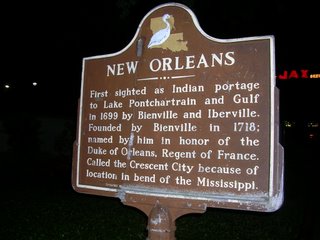
I have been home for a day and a half now. The situation in New Orleans seems to have a more powerful impact now that I've left. Perhaps that while there, it was so commonplace, and so many people had seen much worse, that I was almost taking it for granted.
Public schools reopened on Tuesday. This week. EIGHT months after the hurricane. Two months ago--six months after the hurricane--most stoplights weren't working and trashed/flooded cars and other debris still littered the streets. Now, most stoplights work and the streets are fairly clear. Plenty of roads were themselves damaged by the waters, and you still saw lots of stranded cars along the sides of streets, but overall things were fairly normalized.
Buildings are still intact in New Orleans; it's not the utter destruction that the Mississippi Coast saw. However, the water lines go forever in some neighborhoods. Some neighborhoods have no water lines at all. The city was built on different heights depending on class. The plantation and slave-owners' houses are built on higher land, and the slave quarters were built on the lower land. Those class distinctions from 150 years have carried over to now, so that the poor were overproportionally affected by the floods. Of course, there were plenty of middle-class homes affected too; they just didn't show that on tv.

At first I thought that things were livening up. You saw cars driving, lights on, people walking--IF you went to Canal Street or the French Quarter. Even so, many shops and other businesses are still closed. I saw more people in one block of Queens yesterday than I did on Wednesday afternoon on the whole of Canal Street, which is a long main thoroughfare running north-south. Cafe du Monde (above) is back serving their famous beignets (squares of fried dough covered in powdered sugar), and Bourbon Street is 'open.' However, I know that they are relatively empty compared to the pre-hurricane economy. Most, not all, bars are open, but most of them also stood empty.

The heat is already oppressive, especially to my sensitive temperate-climate-raised notions. I kept forgetting that it's only mid-April. Also, the hurricane season starts in June. Again.
Hands On has been a huge presence in the Biloxi/Gulfport area since October or November. In general, there are tons of volunteers and groups helping out over there, and not nearly as many in New Orleans. The Hands On chapter only got to New Orleans in February. They're already two months' behind in fulfilling work orders and cannot take anymore. They lead volunteers out to the community and gut damaged houses, at no fee to the homeowner. They also remove and treat for mold.
I worked in one house for several days. The house was raised at least three feet off the ground, and the water line was at least four feet. That means there was at least seven or eight feet of water there. And the damage did not only extend to the things the water touched. Most of the ceiling had fallen down and become part of the floor. The mold grew up the walls to the ceilings.
More on that in another post.
But all that seems almost irrelevant when you consider the Ninth Ward (see next post with pictures). Wards are like neighborhoods or suburbs or something, and the Ninth sits immediately to the east of one of the leveed canals. The gap in the levee was astonishing. I tried to, but could not, imagine what it must have been like when the water breached or broke that levee. A wall of water must have submerged the entire neighborhood within a few minutes. Most of the houses there were not built on real foundations; they were propped up on concrete blocks. When all that water poured in, it just lifted up the houses. Some dropped back down almost on their blocks, sinking in the middle. Other houses were left stranded in streets, or crashed into trees, or crashed into other houses, or just completely demolished into nothing but planks and splinters.
It was unbelievable, surreal, and horrible. Looking at it felt like seeing some kind of natural holocaust, except we know that it's the fault of humans. There were no people there at all. Why would there be? Everything was destroyed, even if the shell of the house was still there. Whole fields and yards lay bare where less than a year ago were residences.
It struck me that some may think taking so many pictures of the destruction is morbid and exploitative. Actually, I believe that it's actually doing something to honor and remember the reality of the situation. A way to remind us of the awful things to help prevent more in the future.
1 comment:
Thank you for the pics. I kept the address of your blog on the computer at work so that after "easter vacation" I can show it to one of my co-worker. She is a really nice person, a nice co-worker but most of the time she is is extremly prejudiced against the US and she does not even realize it. I hope to have a healthy discussion with her about the situation in N.O and the US in genral with the help of your pictures.
Post a Comment